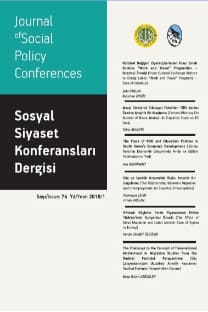Malmquist Indices of Productivity Change in Turkish Banking Sector for the Period Between 2002 – 2011
The aim of
this study is to investigate the changes of efficiency in the Turkish Banking
Sector for the years between 2002 – 2011. The Turkish economic system was hit
by two serious financial crises in the late 1990s and early 2000s and as a
result economic system collapsed in 2001. It is obvious that the strong finance
sector is crucial for the economy as a whole and the banking sector is the most
important part of a financial sector in Turkey. The financial resources are
collected and allocated to the real sector through banking sector. In this
context analysis of the financial sector, which will contribute to operate
efficiently, is great of importance. Within this framework in the present study
some different efficiency measuring techniques have been introduced. The widely
used non-parametric Data Envelopment Analysis (DEA) is considered one of these
techniques and Malmquist Productivity Indices (MPI) is used to investigate the
levels and the changes in the efficiency.
Anahtar Kelimeler:
Data Envelopment Analysis, Malmquist indices, Banking Sector, Efficiency
___
- Akin, M. K. And S. Zaim (2009, June). Determinants Of Bank Efficiency In Turkey: A Two Stage Data Envelopment Analysis. International Symposium On Sustainable Development, 32–41. Alam, Ila, and M. Semenick (2001) A Nonparametric Approach for Assessing Productivity Dynamics of Large U.S. Banks”, Journal of Money, Credit, and Banking, Vol. 33, No.1 Aydogan, K., C. G. (1989). Bankacilik Sisteminde Etkinlik Ve Verimlilik Uluslararasi Bir Karsilastirma. Milli Produktivite Merkezi Yayinlari, Yayin No:397. Berg, S., Førsund, F., and Jansen, E. (1992). Malmquist Indices of Productivity Growth during the Deregulation of Norwegian Banking, 1980-89. The Scandinavian Journal of Economics, 94, S211-S228. doi:10.2307/3440261 Bjurek, H. (1996) The Malmquist Total Factor Productivity Index, The Scandinavian Journal of Economics, 98(2), 303-313 Caves, Douglas W and L. R. Christensen and W. Diewert (1982) The Economic Theory of Index Numbers and the Measurement of Input, Output, and Productivity, Econometrica, 50(6), 1393-1414, https://EconPapers.repec.org/RePEc:ecm:emetrp:v:50:y:1982:i:6:p:1393-1414 Charnes, A., W. W. Cooper, And E. Rhodes (1978). Measuring The Efficiency Of Decision Making Units. European Journal Of Operational Research 2(6), 429–444. Coelli, T. E. A. (1998). An Introduction To Efficiency And Productivity Analysis. Kluwer Academic Publisher,. Dacanay III, Santos José O. (2007). Malmquist Indices And Technical Efficiency Of Philippine Commercial Banks In The Post-Asian Financial Crisis Period. Philippine Management Review 17, 93–114. Efendi, V. (2011). Efficiency Of The Banking Sector Of Bosnia Herzegovina With Special Reference To Relative Efficiency Of The Existing Islamic Bank. Färe, R. and Grosskopf, S. (Jan., 1992) Malmquist Productivity Indexes and Fisher Ideal Indexes, The Economic Journal, Vol. 102, No. 410, 158-160 Färe, R., Grosskopf, S., Lindren, B., & Roos, P. (1989, 1994). Productivity change in Swedish hospitals: a Malmquist output index approach. In A. Charnes, W.W. Cooper, A. Y. Lewin, & M. L. Seiford (Eds.) Data envelopment analysis: Theory, methodology and applications. Boston: Kluwer Academic Publishers. Färe, R., Grosskopf, S., & Russel, R. (1998). Index numbers: Essays in honour of Sten Malmquist. Boston: Kluwer Academic Publishers. Inan, E. A. (2004). Dezenflasyon Sureci Ve Dusuk Enflasyon Ortami:Turkiye’de Makroekonomi Ve Bankacilik Uzerine Etkileri. Bankacilar Dergisi 50. Kirikal, Ly (2005). Productivity, The Malmquist Indices And The Empirical Study Of Banks In Estonia. 109-130. Kirikal, Ly, Mart Sorg and Vello Vensel (2004). Estonian Banking Sector Performance Analysis Using Malmquist Indiceses And Dupoint Financial Ratio Analysis. International Business And Economic Research Journal 12, 21–36. Malmquist, S. (1953) Index Numbers, And Indifference Surfaces,Trabajos De Estatistica, 4, 209-242, https://link.springer.com/content/pdf/10.1007%252FBF03006863.pdf (20/10/2011) Mercan, M. and A. Reisman (2003). The Effect Of Scale And Mode Of Ownership On The Financial Performance Of The Turkish Banking Sector: Results Of A DEA-Based Analysis. Socio-Economic Planning Sciences 37 (6), 185–202. Neal, P. (2004), X-efficiency and productivity change in Australian banking, Australian Economic Papers, 43, 174 – 191. Ozkan Gunay, E. N. And A. Tektas (2006). Efficiency Analysis Of The Turkish Banking Sector In Precrisis And Crisis Period: A Dea Approach. Contemporary Economic Policy 24(3), 418–431. Sathye, M. (2002) "Measuring productivity changes in Australian banking: an application of Malmquist indices", Managerial Finance, Vol. 28 Issue: 9, pp.48-59, https://doi.org/10.1108/03074350210768068 Seyrek, I. H. And H. A. Ata (2010). Veri Zarflama Analizi Ve Veri Maden- Ciligi Ile Mevduat Bankalarinda Etkinlik Olcumu. BDDK Bankacilik Ve Finansal Piyasalar 4, 67–84. Tatjé, E. G. and C. A. K. Lovell (1995) A Note on the Malmquist Productivity Index, Economics Letters, 47, 169-175 Thrall, R.M. (2000). Measures in DEA with an application to the Malmquist index. Journal of Productivity Analysis, 13, 125-137. Tripe, D. W L. (2005). How should we measure bank efficiency where we don't have many banks? The 18th Australasian Finance and Banking Conference, December 14-16, Shangri-La Hotel, Sydney, NSW. Wallace, L.-K. (2009). Quantifying Management’s Role In Bank Survival Using Data Envelopment Analysis (Dea): Case Of Jamaica. Wheelock, D.C. and P.W. Wilson (1999), Technical Progress, Inefficiency, And Productivity Change In U.S. Banking, 1984–1993, Journal Of Money, Credit, And Banking 31, 212–234
- ISSN: 1304-0103
- Yayın Aralığı: Yılda 2 Sayı
- Başlangıç: 1948
- Yayıncı: İstanbul Üniversitesi Yayınevi
Sayıdaki Diğer Makaleler
AB Ülkeleri ve Türkiye Arasında Sosyal Güvenlik Sorunlarının Genel Bir Karşılaştırması
İnsan Kaynakları Fonksiyonlarının Mukayeseli Önem Derecelerinin Belirlenmesi Üzerine Bir Uygulama
Üniversite Öğrencileri Arasında İşsizlik Riski, Kariyer Beklentileri ve Siyasal Marjinalleşme
